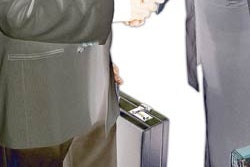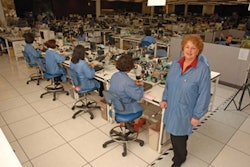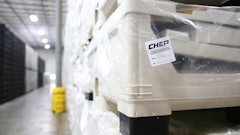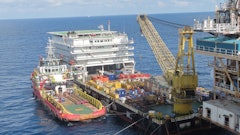
Len Prokopets with Archstone Consulting
By Len Prokopets
As recently as last year, before the global economy's plunge into recession, U.S. manufacturers were becoming increasingly concerned about the hidden costs of offshoring. Many manufacturers responding to an Archstone Consulting survey reported alarming growth in offshore labor rates, exchange rates, commodity costs, transportation costs and a variety of soft costs that had spiked their offshore manufacturing costs by 25 percent or more in the last three years.
At the time, we suggested — and responses to our survey supported — a trend developing among many manufacturers to rethink their offshoring strategies. In fact, 90 percent of the survey's respondents reported that they had already begun rebalancing their manufacturing and supply strategies or were considering doing so.
We had argued that manufacturers can make more informed sourcing and manufacturing network design decisions by considering "total cost," and that on-shore or near-shore manufacturing would increasingly be an attractive option. Many in the media shared our view and heralded the return of manufacturing to the U.S.
Since then, as the recession swamped the global economy, the acute pain caused by rising costs of offshoring has diminished — transportation and commodity costs for offshore manufacturing have declined as oil prices eased and labor and exchange rate growth have leveled off. Some have argued that this shift has opened the door for companies to resume their prior "rapid-fire" offshoring and that the return of manufacturing to the U.S. would not materialize.
We disagree with this view. Manufacturers' responses to our survey indicate that they have seen what seemed like bullet-proof business cases for offshoring be negated by growth of transportation, commodity, exchange and labor rates. In fact, 59 percent of manufacturers report that they are being more selective in making offshoring decisions or are relocating manufacturing/sourcing to avoid those risks. [See Chart 1 in pop-up box (may need to turn off pop-up blockers to view this and other illustrations in this article.]
Further, manufacturers' responses to our survey point to the fact that they have realized that offshoring carries "hidden" costs in the form of soft costs such as lost flexibility and secondary hard costs such as the cost of excess inventory and increased cost of managing quality. [See Chart 2 and Chart 3.]
Shorter supply networks simply favor greater product flexibility, network visibility and the ever-present need to meet customer expectations for value, service, timeliness and innovation. A number of manufacturers, responding to our blog on this debate, seemed to agree:
Despite the generally accepted rule-of-thumb perception that offshoring, to countries such as China, generated 25-40 percent savings, we continue to believe that the actual savings may never have been more than 15 percent and for some products as little as 5 percent when considering all-in costs.
As our survey discovered, only a very few of the respondents have been basing their offshoring decisions on a true total cost model. As a result, the hidden costs referenced already were never captured and included in their cost projections. The good news here is that more than 66 percent of manufacturers reported in our survey plans to apply total cost analysis in their sourcing decisions going forward. [See Chart 4.]
Such a total cost analysis should include not only "hard costs" such as transportation, packaging, inventory and handling costs, but often-hidden "soft costs," including:
While the economic downturn has been deeper and more protracted than some had predicted, the downturn will eventually end. The increases in costs that had eroded many advantages of offshoring — offshore commodities and transportation — will return. Offshore labor rates are likely to continue to rise, as is the valuation of the Chinese yuan and other currencies.
Interestingly, the Big Mac Index, the Economist magazine's index of purchasing power parity in various nations, published in July 2009, indicates that the Chinese yuan may still be 49 percent overvalued vs. the U.S. Dollar. You can read the article (trial registration/subscription required) at www.economist.com/businessfinance/displaystory.cfm?story_id=14036918.
In fact, our analysis [Chart 6] indicates that shifts are already happening in each of these cost factors and are eroding the recent and temporary gains in relative advantages of offshoring.
Further, as the economic downturn has progressed, manufacturing utilization in the U.S. has fallen 20 percent from its five-year high in 2006 [Chart 5]. This excess manufacturing capacity offers buyers an excellent opportunity to lock in historically low rates on U.S. production resources. It also opens the door for opportunities to secure tax and other incentives.
We believe that manufacturers will continue to aggressively seek to reduce costs and will continue to seek the lowest-cost manufacturing/sourcing location for their goods. We are optimistic, however, that the two-thirds of manufacturers citing total cost analysis as a key required capability going forward will begin to shift from a "low-cost country" sourcing approach to a "low-total-cost country" approach.
Leading organizations are beginning to adopt a robust total cost model [Chart 7] for sourcing that considers not just supplier price and terms, but also other "hard costs" including transportation, packaging, inventory and handling costs, as well as "soft costs" such as impact on supply risk and impact on the ability to provide customer service. ¦
About the Author: Len Prokopets is principal and Sourcing and Procurement Practice co-leader for Archstone Consulting.
As recently as last year, before the global economy's plunge into recession, U.S. manufacturers were becoming increasingly concerned about the hidden costs of offshoring. Many manufacturers responding to an Archstone Consulting survey reported alarming growth in offshore labor rates, exchange rates, commodity costs, transportation costs and a variety of soft costs that had spiked their offshore manufacturing costs by 25 percent or more in the last three years.
At the time, we suggested — and responses to our survey supported — a trend developing among many manufacturers to rethink their offshoring strategies. In fact, 90 percent of the survey's respondents reported that they had already begun rebalancing their manufacturing and supply strategies or were considering doing so.
We had argued that manufacturers can make more informed sourcing and manufacturing network design decisions by considering "total cost," and that on-shore or near-shore manufacturing would increasingly be an attractive option. Many in the media shared our view and heralded the return of manufacturing to the U.S.
Since then, as the recession swamped the global economy, the acute pain caused by rising costs of offshoring has diminished — transportation and commodity costs for offshore manufacturing have declined as oil prices eased and labor and exchange rate growth have leveled off. Some have argued that this shift has opened the door for companies to resume their prior "rapid-fire" offshoring and that the return of manufacturing to the U.S. would not materialize.
We disagree with this view. Manufacturers' responses to our survey indicate that they have seen what seemed like bullet-proof business cases for offshoring be negated by growth of transportation, commodity, exchange and labor rates. In fact, 59 percent of manufacturers report that they are being more selective in making offshoring decisions or are relocating manufacturing/sourcing to avoid those risks. [See Chart 1 in pop-up box (may need to turn off pop-up blockers to view this and other illustrations in this article.]
Further, manufacturers' responses to our survey point to the fact that they have realized that offshoring carries "hidden" costs in the form of soft costs such as lost flexibility and secondary hard costs such as the cost of excess inventory and increased cost of managing quality. [See Chart 2 and Chart 3.]
Shorter supply networks simply favor greater product flexibility, network visibility and the ever-present need to meet customer expectations for value, service, timeliness and innovation. A number of manufacturers, responding to our blog on this debate, seemed to agree:
- "A deciding factor has to be related to service of the customer."
- "For every dollar saved on sending casting, forgings and fabrications overseas, I can point to two you lost. Quality and logistics are the real problems for most organizations. When your parts are coming from overseas, the idea of JIT purchasing is nearly impossible."
- "[With] proximity to the U.S. market, the time to get the engineering down and the production up is less, and costs are generally lower from a total cost perspective. Inventory can be reduced by greater than 50 percent vs. those operations that are in Asia with goods on the boat."
Despite the generally accepted rule-of-thumb perception that offshoring, to countries such as China, generated 25-40 percent savings, we continue to believe that the actual savings may never have been more than 15 percent and for some products as little as 5 percent when considering all-in costs.
As our survey discovered, only a very few of the respondents have been basing their offshoring decisions on a true total cost model. As a result, the hidden costs referenced already were never captured and included in their cost projections. The good news here is that more than 66 percent of manufacturers reported in our survey plans to apply total cost analysis in their sourcing decisions going forward. [See Chart 4.]
Such a total cost analysis should include not only "hard costs" such as transportation, packaging, inventory and handling costs, but often-hidden "soft costs," including:
- lost supply chain visibility;
- container load management in lieu of mass customization as a competitive differentiator;
- reduced ability to use operations and the supply chain to deliver more product customization;
- overall supply chain risk;
- risk to intellectual properties;
- reduced SKUs and less flexible ordering patterns;
- product quality issues;
- more complex quality resolution;
- additional warehousing and related higher inventory costs.
While the economic downturn has been deeper and more protracted than some had predicted, the downturn will eventually end. The increases in costs that had eroded many advantages of offshoring — offshore commodities and transportation — will return. Offshore labor rates are likely to continue to rise, as is the valuation of the Chinese yuan and other currencies.
Interestingly, the Big Mac Index, the Economist magazine's index of purchasing power parity in various nations, published in July 2009, indicates that the Chinese yuan may still be 49 percent overvalued vs. the U.S. Dollar. You can read the article (trial registration/subscription required) at www.economist.com/businessfinance/displaystory.cfm?story_id=14036918.
In fact, our analysis [Chart 6] indicates that shifts are already happening in each of these cost factors and are eroding the recent and temporary gains in relative advantages of offshoring.
Further, as the economic downturn has progressed, manufacturing utilization in the U.S. has fallen 20 percent from its five-year high in 2006 [Chart 5]. This excess manufacturing capacity offers buyers an excellent opportunity to lock in historically low rates on U.S. production resources. It also opens the door for opportunities to secure tax and other incentives.
We believe that manufacturers will continue to aggressively seek to reduce costs and will continue to seek the lowest-cost manufacturing/sourcing location for their goods. We are optimistic, however, that the two-thirds of manufacturers citing total cost analysis as a key required capability going forward will begin to shift from a "low-cost country" sourcing approach to a "low-total-cost country" approach.
Leading organizations are beginning to adopt a robust total cost model [Chart 7] for sourcing that considers not just supplier price and terms, but also other "hard costs" including transportation, packaging, inventory and handling costs, as well as "soft costs" such as impact on supply risk and impact on the ability to provide customer service. ¦
About the Author: Len Prokopets is principal and Sourcing and Procurement Practice co-leader for Archstone Consulting.



















